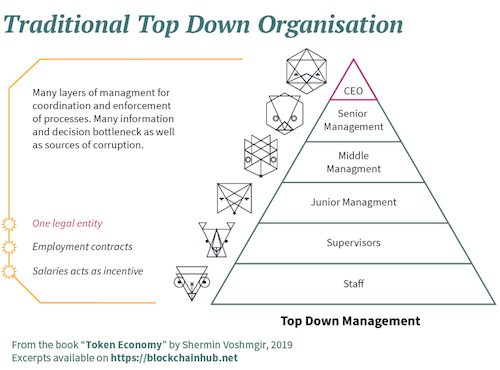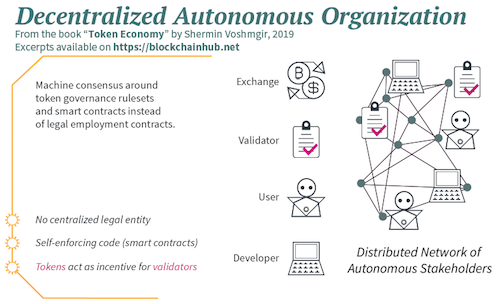They’re decentralized, trustless, rapid and easy to access, and they tend to concentrate on spaces where those features are of the most benefit, including DeFi.
In this post we’ll briefly look at what a DAO is, then move on to discussing how they work and some of the best-known examples. If you already know what a DAO is, feel free to skip, but otherwise,we’ll start there.
What is a DAO?
A DAO is a Decentralized Autonomous Organization. Decisions at the organizational level are taken through voting structures where all members can vote, or through consensus-based models, but all DAOs lack centralized organizational structures. There’s no boss, C suite or leadership.
Most DAOs operate using smart contracts to establish internal rules which then can’t be violated, and which require a vote or consensus to change. This is similar to an amendment to a national constitution, or an EIP on the Ethereum blockchain. In fact, Ethereum is quite bullish on DAOs, as it explains:

Because of these organizational features, DAOs represent a way to safely collaborate with strangers online to achieve shared objectives, whether that’s a specific project or a more general, longer-term goal. Trust is not required, and neither is the intervention of a trusted intermediary. DAOs can also be used for fundraising on the same trustless, secure basis.
How do DAOs work?
There’s a lot of detail, and many potential models for DAOs. But one common voting system is weighted voting, where increased stake in the organization increases the weight of your vote. Typically, this stake is acquired by purchasing specific governance tokens, or being given them as rewards for performing or participating in the tasks the DAO has arranged for itself.
As always, fully-open organizations face a threat from bad actors and spam, and many DAOs solve this by having a pre-vote sorting mechanism requiring proposals to gain a certain level of support before the whole organization is able to vote on them. There are sometimes also vetting systems for members or voting outcome thresholds, in order to prevent collusion by multiple accounts or manipulation by larger stakeholders.
The underlying technology may be different, but otherwise this is very similar to the voting methods used by the committees of centralized organizations, from clubs to governments. The difference is twofold. First, in a DAO, every member is a part of the committee that votes on policy and rules changes. Second, DAOs are built on blockchains, meaning they’re secure, private, and transparent. Anyone can audit treasuries and transactions, but fudging votes, amending minutes or cheating the rules is impossible. DeFi projects often either plan to, or are actively working to, become DAOs.
Traditional organizations vs DAOs
Traditional organizations operate as a single legal entity. With the exception of very small businesses, most jurisdictions treat a business as a “legal person”. It can own property, pay fines and in other ways be treated like a person by the courts. And it can buy and sell things in the marketplace. In fact, this legal personhood for organizations is fairly similar to the “first class citizenship” smart contracts enjoy on blockchains like Ethereum.
Inside the organization, there’s a unitary hierarchical structure. At the top is the leadership team; at the top of that team is the CEO, answerable in theory to the shareholders but in the age of stock buybacks and multimillionaire CEOs, increasingly answerable only to the organization’s — and their own — continuing financial success. Below the leadership team are managers whose departments are similarly structured. Information flows up the organization, decisions are made by managers, leaders and the CEO, and instructions flow back down the hierarchy.

By contrast, a DAO mirrors the flatter, more weblike hierarchical structures that many traditional organizations have spent a decade or more seeking to transition towards, often with limited success. Instead of a small number of stakeholders and a much larger number of work-for-hire staff whose incentive is their salary and associated benefits, there’s a distributed network of autonomous stakeholders. The structure of DAOs, as well as the effects of geographic distribution characteristic of mainly-online groups, means DAO participants tend to identify more with the work, less with the organization.

DAOs in action
So much for the theory. What do DAOs look like in action? There are several DAO-based projects up and running already, and more in the works. We’ll start with the most venerable and well-known, MakerDAO.
MakerDAO
Maker is an open source community that manages Dai, DeFi’s most popular digital asset-collateralized stablecoin and lending protocol. With nearly $10 billion locked in the protocol, Maker combines loans in digital assets — which can be price-unstable — with a stablecoin to ensure predictable repayments.
The great appeal of Maker, as the name suggests, is that it enables anyone with ETH and a MetaMask wallet to loan money to themselves. ETH is locked on the Maker protocol (around 2% of all ETH is currently locked this way) and DAI, one of Maker’s two tokens, is created to represent it. When users are ready to reclaim their ETH they simply buy it back at an agreed-upon rate, plus any fees. Profit derives from increases in the value of DAI in the time between locking and recovering.
CurveDAO
CurveDAO is a decentralized Automated Market Maker (AMM) that provides revenue to token holders who lock their tokens. Voting rights and revenue accrue to users in proportion to how long their tokens are locked rather than equity.
PieDAO
PieDAO creates index products that bundle multiple coins in risk-mitigated EFTs. The company describes itself as “a decentralized asset manager for tokenized portfolios, with a mission to bring automated wealth creation to everyone with an internet connection.”
Aragon
Aragon is a DAO for DAOs, a project that builds tools for other decentralized organizations to collaborate. The project offers a platform to build and deploy DAOs, including BrightID, a project for collaboratively managing resources with a larger number of stakeholders than can be accommodated by multisig wallets.
DXDAO
DXDAO is another DAO of DAOs, this time specifically DeFi-oriented and designed to support DeFi projects seeking DAO status as well as associated projects like Rails.eth, a digital assets micropayments processor.
Why DAOs matter
DAOs are a crucial factor in the digital asset economy because they create frameworks and incentives for decentralized organizations, whose structure mirrors that of the wider digital assets economy. Using organizations structured this way, DAO projects have shown their ability to grow fast, attract significant investments, and function well from a business perspective, without recourse to traditional company structures. UniSwap, operated by a DAO in which the core development team and anyone who holds UNI can participate in decision-making, is a good example of this. DAOs allow members to be simultansouely users, investors and operators.
Digital assets generate efficiency gains by removing trust from transactions. Now, parties can exchange without knowing or trusting each other and without needing an intermediary, and without the potential costs previously associated with this. DAOs generate efficiency gains by removing trust from organizations. Now, organizations’ members can work, plan, steer, vote and use the product, all without knowing or trusting each other or a trusted third party in the form of a conventional company structure. In many cases, just as with parties to a digital asset transaction on an exchange, the members of a DAO don’t even know each others’ real names.
Despite this, DAOs are less likely to fall victim to bad actors than more conventionally-structured digital assets companies. There’s no “central team” that can steer the project onto the rocks, perform exit scams or otherwise attack the project from within. And, if the code is properly written, there’s no way for users to collude, spam or damage the network either. We can expect DAOs to adopt a more central role over the coming years.
